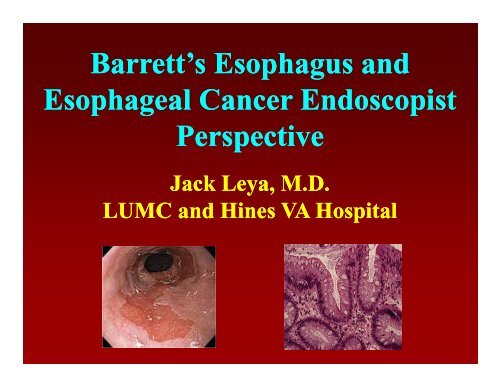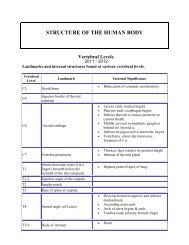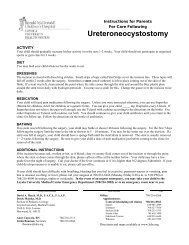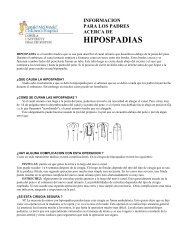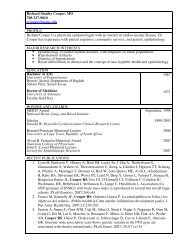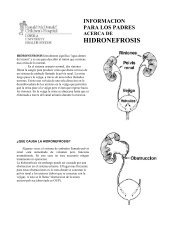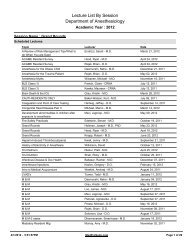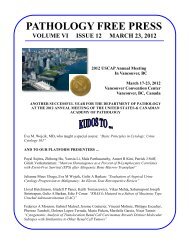Barrett's Esophagus and Barrett s Esophagus and Esophageal ...
Barrett's Esophagus and Barrett s Esophagus and Esophageal ...
Barrett's Esophagus and Barrett s Esophagus and Esophageal ...
Create successful ePaper yourself
Turn your PDF publications into a flip-book with our unique Google optimized e-Paper software.
<strong>Barrett</strong>’s <strong>Barrett</strong> s <strong>Esophagus</strong> <strong>and</strong><br />
<strong>Esophageal</strong> Cancer Endoscopist<br />
Perspective<br />
Jack Leya, M.D.<br />
LUMC LUMC <strong>and</strong> <strong>and</strong> Hines Hines VA Hospital
Learning Objectives<br />
• Define <strong>Barrett</strong>’s <strong>Esophagus</strong><br />
• Recognize g risk factors for <strong>Barrett</strong>’s<br />
esophagus <strong>and</strong> esophageal cancer<br />
• Recognize g natural history y of <strong>Barrett</strong>’s, ,<br />
dysplasia <strong>and</strong> its progression to cancer<br />
• Discuss the role of endoscopic p management g<br />
of <strong>Barrett</strong>’s esophagus <strong>and</strong> early esophageal<br />
cancer
Case #1<br />
Pt 56 yow yowf, , cchronic o c G GERD, , oon PPI’s s for o >10y. 0y. Sy Symptoms p o s oof GGERD we well<br />
controlled but has occasional dysphagia. EGD done in outside hosp<br />
showed short segment <strong>Barrett</strong>’s. Biopsies reviewed by two<br />
independent pathologists showed <strong>Barrett</strong>’s with HGD <strong>and</strong><br />
Intramucosal tumor. Patient was referred to LUMC for further<br />
managfement.<br />
PMH: HTN,hyperlipidemia,s/p PTCA.<br />
Meds: PPI, ASA, Plavix, Lopressor, Crestor, Lisinopril<br />
P.E. essentially normal…<br />
2009<br />
2010
<strong>Barrett</strong>’s <strong>Esophagus</strong>-? Congenital short esophagus
<strong>Barrett</strong>’s <strong>Esophagus</strong><br />
• Probably a successful response to severe<br />
reflux<br />
• Usually; bad LES, hiatal hernia,<br />
compromised motility<br />
• Is it acid, or bile or both<br />
• Wh Why some develop d l <strong>Barrett</strong>’s B ’<br />
• Why some (few) develop cancer
<strong>Barrett</strong>’s <strong>Barrett</strong> s <strong>Esophagus</strong><br />
• Multiple definitions of <strong>Barrett</strong>’s have been used;<br />
three ttypes pes of columnar col mnar epithelia have ha e been<br />
described, gastric fundic type, gastric cardia <strong>and</strong><br />
intestinal
Definition<br />
Definition: Specialized intestinal (columnar)<br />
epithelium in the esophagus is “Sine Sine Qua Non Non”<br />
Gastroenterology Vol.140, No. 3, 2011
<strong>Barrett</strong>’s <strong>Esophagus</strong> - Epidemiology<br />
Prevalence in GERD Patients<br />
Author<br />
S Spechler hl (1994)<br />
Weston (1996)<br />
Johnston (1996)<br />
Chalasani (1997) ( )<br />
Hirota (1999)<br />
Average<br />
LSBE LSBE<br />
1%<br />
7%<br />
1%<br />
6%<br />
2%<br />
3.4%<br />
SSBE SSBE<br />
12%<br />
8%<br />
2%<br />
8%<br />
6%<br />
7.2%<br />
ALL BE<br />
13%<br />
15%<br />
3%<br />
14%<br />
8%<br />
10.6%
<strong>Barrett</strong>’s <strong>Esophagus</strong> - Epidemiology<br />
Endoscopic<br />
B <strong>Barrett</strong>’s tt’<br />
Prevalence by Ethnicity<br />
10<br />
8<br />
6<br />
4<br />
2<br />
>50,000<br />
procedures;<br />
Overall BE<br />
prevalence: 6.6%<br />
(n=3357)<br />
0<br />
Caucasians Hispanic Asian African-<br />
s s A American i<br />
CORI Data, DDW 2001<br />
s
<strong>Barrett</strong>’s <strong>Esophagus</strong> - Epidemiology<br />
Risk Factors<br />
Increasing age<br />
Men<br />
Caucasians<br />
Longst<strong>and</strong>ing GERD<br />
symptoms y p<br />
Conio M, et al. Int J Cancer 2002; 97:225<br />
Lieberman DA, et al. Am J Gastroenterol 1997; 92:1293
Acid <strong>and</strong> Pepsin Damage Tight Junctions<br />
<strong>Barrett</strong>’s <strong>Esophagus</strong> - Pathophysiology<br />
A Acid id <strong>and</strong> d Pepsin P i Damage D Tight Ti ht Junctions J ti<br />
Damaged<br />
junctions<br />
Increased<br />
paracellular<br />
permeability<br />
Widened<br />
Basal<br />
layer<br />
Tight<br />
junction j Acid<br />
cell<br />
junction j<br />
Tobey NA, et al. Am J Gastroenterol 2004;<br />
99:13<br />
Pepsin
<strong>Barrett</strong>’s <strong>Esophagus</strong> - Epidemiology<br />
%<br />
Endoscopic<br />
<strong>Barrett</strong>’s<br />
Duration of Reflux Symptoms <strong>and</strong> Risk of<br />
<strong>Barrett</strong>’s <strong>Esophagus</strong><br />
25<br />
20<br />
15<br />
10<br />
5<br />
0<br />
< 1 year 1-5 yrs 5-10 yrs > 10 yrs<br />
Symptom<br />
duration<br />
Lieberman, et al. Am J Gastroenterol 1997; 92:1293
<strong>Barrett</strong>’s <strong>Esophagus</strong> - Pathophysiology<br />
Bil Bile RReflux fl iis IIncreased d iin <strong>Barrett</strong>’s B tt’<br />
% Time bilirubin<br />
absorbance<br />
0.14 0.14 0.14<br />
50<br />
40<br />
30<br />
20<br />
10<br />
0<br />
Control GERD <strong>Barrett</strong>’s<br />
p
The Role of H. pylori in <strong>Barrett</strong>’s<br />
<strong>Esophagus</strong><br />
H. pylori py Infection is not more common in<br />
<strong>Barrett</strong>’s<br />
Th The inverse i relationship l ti hi between b t H. H pylori l i<br />
<strong>and</strong> adenocarcinoma is controversial<br />
-conflicting fli ti results lt from f different diff t studies t di of f<br />
Cag A+<br />
“Protective” role regarding esophageal<br />
adenocarcinoma controversial because<br />
epidemiologic id i l i association i ti does d not t prove<br />
causation !
<strong>Barrett</strong>’s <strong>Esophagus</strong> - Pathophysiology<br />
Potential Relationship<br />
Between H. pylori py <strong>and</strong><br />
<strong>Barrett</strong>’s<br />
GERD is uncommon in regions of<br />
world where most people are<br />
colonized by H. pylori<br />
GERD <strong>and</strong> its sequelae sequelae are<br />
increasing g in countries where H.<br />
pylori prevalence is decreasing<br />
Peek RM <strong>and</strong> Blaser MJ, Nature Reviews Cancer 2002; 2:28
<strong>Barrett</strong>’s <strong>Esophagus</strong> - Epidemiology<br />
Al Alcohol h l Use U Does D NNot t IIncrease Ri Risk k of f<br />
<strong>Esophageal</strong> Adenocarcinoma<br />
Alcohol use Odds Ratio 95% CI<br />
Never 1.0 referent<br />
> 35 drinks per week 0.9 0.5-1.6<br />
> 70 g/w 0.6 0.3-1.1 0.3 1.1<br />
Gammon MD, et al. J Natl Cancer Inst 1997; 89:1277<br />
Lagergren J, et al. Int J Cancer 2000; 85:340
Endoscopic Evaluation<br />
• Short segment 3 cm.<br />
• Prague criteria Circmuferential (C) <strong>and</strong><br />
Maximum extend (M) ( )<br />
Sharma P, Dent J, Armstrong D, et al. Gastroenterology 2006;131:1392-1399
<strong>Barrett</strong>’s <strong>Esophagus</strong> - Epidemiology<br />
Patients<br />
(%)<br />
20<br />
15<br />
10<br />
5<br />
0<br />
PPrevalence l of f Dysplasia D l i <strong>and</strong> d<br />
Cancer in BE <strong>and</strong> CIM<br />
LSBE<br />
n = 40<br />
Hirota, et al. Gastroenterology 1999; 116:277<br />
SSBE<br />
n = 64<br />
Dysplasia<br />
Cancer<br />
CIM<br />
n = 47
NDBE Natural History
<strong>Barrett</strong>’s <strong>Esophagus</strong> - Surveillance<br />
Variable Progression Progression of of HGD HGD to Cancer –<br />
Adjusted for Referral Bias <strong>and</strong> Prevalence<br />
Cases<br />
Schnell, , et al.<br />
(n=75)<br />
Reid, et al.<br />
(n=76)<br />
Surveillance<br />
Period<br />
16% 7.3 7 77.3 3 years<br />
24% 5 years<br />
0% 10% 20% 30% 40% 50% 60% 70%<br />
Reid, et al. Am J Gastro 2000; 95:1669<br />
Schnell, et al. Gastro 2001; 120:1607
<strong>Barrett</strong>’s <strong>Esophagus</strong> - Screening<br />
American College of Gastroenterology<br />
Screening Guidelines<br />
Chronic GERD symptoms<br />
Male<br />
C Caucasian i<br />
Older age age g<br />
Sampliner RE, Am J Gastroenterol 2002; 97:1888
2005 Estimated US Cancer<br />
Deaths*<br />
Lung <strong>and</strong> bronchus<br />
Prostate<br />
31%<br />
10%<br />
Men<br />
295,280<br />
Women<br />
275,000<br />
27%<br />
15%<br />
Lung <strong>and</strong> bronchus<br />
Breast<br />
Colon <strong>and</strong> rectum 10%<br />
10% Colon <strong>and</strong> rectum<br />
Pancreas 6%<br />
6% Pancreas<br />
Leukemia 4%<br />
6% O Ovary<br />
<strong>Esophagus</strong> 4%<br />
4% Leukemia<br />
Liver <strong>and</strong> intrahepatic<br />
3% Non-Hodgkin<br />
bil bile d duct t 3%<br />
lymphoma<br />
Non-Hodgkin Lymphoma 3%<br />
3% Uterine corpus<br />
Urinary bladder 3% 2% Multiple p myeloma y<br />
Kidney 3%<br />
All other sites 24%<br />
2% Brain/ONS<br />
22% All other sites<br />
ONS=Other nervous system.<br />
Source: American Cancer Society, 2005.
Survival<br />
Stage Distribution <strong>and</strong> 5-year Relative Survival by Stage at<br />
Diagnosis for<br />
2001-2007, All Races, Both Sexes<br />
Stage at Diagnosis<br />
StageDistribution<br />
(%)<br />
5-year relative Survival<br />
(%)<br />
Localized (confined to primary site) 22 37.3<br />
Regional (spread to regional<br />
lymphnodes)<br />
32 18 18.44<br />
Distant (cancer has metastasized) 32 3.1<br />
Unknown (unstaged) 14 11 11.4 4<br />
Localized to the mucosa 83.0
Epidemiology: Adenocarcinoma<br />
• White men>8x white women<br />
• White men>5x African Americans<br />
• NNew cases iin the h US iin 2010 2010: 16 16,640 640<br />
• Deaths related do Esop Ca: 14, 500
<strong>Barrett</strong>’s <strong>Esophagus</strong> - Epidemiology<br />
GERD S Symptoms t <strong>and</strong> d Ri Risk k of f<br />
<strong>Esophageal</strong> Adenocarcinoma<br />
GERD symptoms<br />
Odds Ratio<br />
95% CI<br />
<strong>Esophageal</strong> adenocarcinoma 7.7 5.3-11.4<br />
Cardia adenocarcinoma 2.0 1.4-2.9<br />
E <strong>Esophageal</strong> h l squamous cancer 11 1.1 0719 0.7-1.9<br />
Lagergren, et al. N Engl J Med 1999; 340:825
<strong>Barrett</strong>’s <strong>Esophagus</strong> - Screening<br />
<strong>Esophageal</strong><br />
Adenocarcinoma<br />
Odd Odds Ratio R ti<br />
GERD DDuration ti <strong>and</strong> d Ri Risk k of f<br />
<strong>Esophageal</strong> Adenocarcinoma<br />
20<br />
15<br />
10<br />
5<br />
0<br />
None 20<br />
Lagergren, et al. N Engl J Med 1999; 340:825<br />
Symptom Duration (Years)
<strong>Barrett</strong>’s <strong>Esophagus</strong> - Epidemiology<br />
Smoking Increases the Risk of<br />
<strong>Esophageal</strong> Adenocarcinoma<br />
Tobacco smoking OR 95% CI<br />
Previous smoker 2.0 1.4-2.9<br />
Current smoker 2.2 1.4-3.3<br />
42 years 2.4 1.5-3.7<br />
Gammon MD, et al. J Natl Cancer Inst 1997; 89:1277<br />
Lagergren J, et al. Int J Cancer 2000; 85:340
<strong>Barrett</strong>’s <strong>Esophagus</strong> - Epidemiology<br />
FFactors t Associated A i t d With <strong>Esophageal</strong><br />
E h l<br />
Adenocarcinoma – Case Control Studies<br />
Risk Factor Magnitude of Association<br />
Odds Ratio 95% CI<br />
Ch Chronic i reflux fl symptoms 77 7.7 5311 5.3-11.4 4<br />
Body mass index 7.6 3.8-15.2<br />
Smoking: current smoker smoker 22 2.2 1433 1.4-3.3<br />
ex-smoker 2.0 1.4-2.9<br />
Prior cholecystectomy 1.3 1.0-1.8<br />
LES relaxing drugs 3.8 2.2-6.4<br />
Aspirin / NSAID use 0.4 0.2-0.6<br />
H. pylori Cag A positive 0.4 0.2-0.8
Incidence Rate of <strong>Esophageal</strong><br />
Adenocarcinoma After Antireflux<br />
Surgery or Medical Therapy: Meta-<br />
analysis<br />
Antireflux Medical<br />
Medical<br />
Therapy in<br />
Surgery Therapy Last 5 Years<br />
(95% CI) (95% CI) (95% CI)<br />
Incidence Rate 3.8 5.3 4.3<br />
Incidence Rate (2.4-6.1) ( 3.6-7.8) (2.6-5.8)<br />
(cancer/1000 patient-years)<br />
From Corey KE et al. Am J Gastroenterol 2003;98:2390-4
<strong>Barrett</strong>’s <strong>Esophagus</strong> - Treatment<br />
Mortality from Esophagectomy is<br />
Related to Hospital Volume<br />
25<br />
20<br />
15<br />
10<br />
5<br />
0<br />
H Hospital it l Volume V l Per P Year Y<br />
Mortality (%)<br />
19<br />
Birkmeyer, et al. N Engl J Med 2003; 349:2117
<strong>Barrett</strong>’s <strong>Esophagus</strong> - Treatment<br />
Rationale for Ablation Therapy<br />
To To reduce the risk of cancer<br />
Avoidance Avoidance of esophageal<br />
resection<br />
Treatment Treatment of early y cancer<br />
Pacifico RJ, et al. Clinical Gastroenterology <strong>and</strong> Hepatology 2003; 1:252<br />
Scheiman JM, et al. Gastrointestinal Endoscopy 2003; 58:244
<strong>Barrett</strong>’s <strong>Esophagus</strong> - Treatment<br />
Techniques for Mucosal Ablation<br />
Mechanical<br />
Endoscopic mucosal resection (EMR)<br />
Th Thermal l<br />
Argon plasma coagulation<br />
Multi-polar Multi polar coagulation<br />
coagulation<br />
Radio-frequency ablation<br />
Lasers: Argon, Nd:YAG, KTP-YAG<br />
Cryoablation<br />
Photochemical<br />
Photodynamic therapy
<strong>Barrett</strong>’s <strong>Esophagus</strong> - Treatment<br />
Argon Plasma Coagulation is Safe<br />
<strong>and</strong> Reverses <strong>Barrett</strong>’s <strong>Esophagus</strong><br />
10 studies (n=231)<br />
86% complete response<br />
(including HGD <strong>and</strong> cancer)<br />
8% had buried <strong>Barrett</strong>’s<br />
mucosa<br />
Complications are chest pain,<br />
strictures, fever<br />
Pereira-Lima JC, Am J Gastroenterol 2000; 97:279<br />
Kahaleh M, Endoscopy 2002; 34:950
<strong>Barrett</strong>’s <strong>Esophagus</strong> - Treatment<br />
Photodynamic Therapy<br />
Balloon<br />
Sodium<br />
Photoradiation Porfimer<br />
Laser
<strong>Barrett</strong>’s <strong>Esophagus</strong> - Treatment<br />
Photodynamic Therapy: Theory<br />
Photodynamic Therapy: Theory<br />
Photosensitizer +<br />
O 2<br />
Neoplastic p<br />
cells<br />
O 2
<strong>Barrett</strong>’s <strong>Esophagus</strong> - Treatment<br />
Long Long-Term Long Long-Term Term Follow-up Follow up After After PDT PDT <strong>and</strong><br />
<strong>and</strong><br />
Nd:YAG<br />
103 patients<br />
Mean follow-up 51<br />
months<br />
5% subsquamous<br />
subsquamous<br />
cancer<br />
5% subsquamous<br />
B <strong>Barrett</strong>’s tt’ mucosa<br />
without dysplasia<br />
100<br />
80<br />
60<br />
40<br />
20<br />
Overholt BF, Gastrointestinal Endoscopy 2003; 58:183<br />
0<br />
Successful<br />
Treatment (%)<br />
LGD HGD Cancer
<strong>Barrett</strong>’s <strong>Esophagus</strong> - Treatment<br />
Adverse Events Observed With<br />
Photodynamic Therapy<br />
100<br />
80<br />
60<br />
40<br />
20<br />
Photosensitivity<br />
Strictures<br />
Vomiting<br />
Constipation<br />
Chest pain<br />
Pyrexia<br />
0<br />
Adverse Events<br />
Wang <strong>and</strong> Nijhawan, Gastrointest Endosc Clin N Am 2000; 10:487
Radiofrequency<br />
Abl Ablation<br />
ti
Anatomy <strong>and</strong><br />
RFA<br />
Targeted Epithelium<br />
Thickness ~500µm<br />
RFA<br />
Ablation depth 500-1,000µm<br />
Approximate EMR<br />
Depth<br />
<strong>Esophageal</strong> epithelium<br />
~500µm µ<br />
Lamina Propria<br />
Muscularis<br />
Mucosae<br />
Submucosa<br />
Muscularis Propria
Radiofrequency Ablation of <strong>Barrett</strong>’s <strong>Esophagus</strong><br />
Shaheen NJ et al; NEJM, May 2009, Vol 360
Radiofrequency Ablation of <strong>Barrett</strong>’s <strong>Esophagus</strong><br />
Shaheen NJ et al; NEJM, May 2009, Vol 360
halo
Cryo-Ablation<br />
Cryo Ablation
Dosimetry<br />
0.5 mm<br />
Am J Gastro 2006;101:S532. Cryo Spray Ablation<br />
(CSA) in the <strong>Esophagus</strong>: Optimization of Dosimetry.<br />
4 x 10<br />
3 x 20<br />
seconds =<br />
Lamina<br />
Propria to<br />
shallow<br />
SSubmucosal b l<br />
injury<br />
seconds =<br />
Submucosal<br />
injury<br />
CControlled by two variables: i<br />
– Primary: Length of tissue<br />
freeze time<br />
– Secondary: Repetitions of<br />
freeze–thaw cycles
CryoSpray Ablation Procedure<br />
Page 50
Results of CryoSpray Ablation for <strong>Esophageal</strong><br />
HGD <strong>and</strong> IMCA in High Risk Risk, , Non-Surgical<br />
Non Surgical Patients<br />
Conclusions: Endoscopic cryotherapy ablation with low pressure liquid<br />
nitrogen spray is effective in HGD <strong>and</strong> IMCA in this heterogeneous group<br />
of high risk patients. 89% response rate for HGD was seen.<br />
66% response rate for Intra Intra-Mucosal Mucosal Cancer<br />
– Heterogeneous g population p p of very y sick p patients<br />
– 32 patients enrolled (71 years; 61 61-79 79 IQR)<br />
– 12 – IMCA<br />
– 20 – HGD<br />
– 27 – completed treatment<br />
– 5 – remain in treatment<br />
– Approximately pp y 2 y year follow up p<br />
– Prospective, single center (non (non-r<strong>and</strong>omized)<br />
r<strong>and</strong>omized)<br />
Dumot, John Adam et al. Results of CryoSpray Ablation for <strong>Esophageal</strong> HGD <strong>and</strong> IMCA in High Risk, Non-Surgical Non Surgical Patients. DDW 2008<br />
abstract. Clevel<strong>and</strong> Clinic Foundation, Clevel<strong>and</strong>, Ohio, USA.
Safety <strong>and</strong> Tolerability of Endoscopic Cryotherapy<br />
Ablation in the <strong>Esophagus</strong>: A Multicenter Study<br />
• Prospective, IRB approved<br />
• 4 4 academic academic medical medical centers<br />
centers<br />
Conclusions – Endoscopic Cryotherapy Ablation:<br />
• Safe <strong>and</strong> well tolerated<br />
• Low rate of serious adverse events<br />
• Unique mechanism of action<br />
• 77 patients; 323 procedures<br />
• No side effects in 22 patients (29%); 155<br />
procedures (48%).<br />
• Mostly mild side effects overall<br />
• 1 SAE (1.3% / 0.31%)<br />
(Gastric perf, Marfan’s syndrome)<br />
• 3 Strictures<br />
Strictures<br />
(3.9% / 0.93%)<br />
Greenwald, Bruce D., Horwhat, J. David, Abrams, Julian A., Lightdale, Charles J., Dumot, John A.
<strong>Barrett</strong>’s <strong>Esophagus</strong> - Treatment<br />
Indications for for Endoscopic Endoscopic Mucosal<br />
Mucosal<br />
Resection (EMR)<br />
Raised lesions Suspicion Suspicion Suspicion of<br />
of<br />
Focal area of<br />
malignancy<br />
dysplasia dysplasia y p<br />
<strong>Barrett</strong>’s<br />
esophagus with<br />
dysplasia<br />
Ell C, Gastroenterology 2000; 118:670
Endoscopic Mucosal Resection<br />
(EMR)<br />
• Total of 349 patients<br />
• EMR done in 279 pts, PDT in 55 pts,APC in 2 pts<br />
• MMean f/ f/u period i d63 63.6 6months th<br />
• Complete response achieved 337 pts (96.6%)<br />
• Surgery was necessary in 13 pts (3.7%) (3 7%)<br />
• Metachronous lesions developed in74 pts (21.5%)<br />
• 56 died of not related disease. No deaths related to<br />
cancer<br />
O. Pech et al. Gut 2008;57 1200-1206
<strong>Barrett</strong>’s <strong>Esophagus</strong> - Treatment<br />
Mucosal Resection Caps
Step 1: Injection of Target Lesion<br />
<strong>Barrett</strong>’s <strong>Esophagus</strong> - Treatment<br />
Step 1: Injection of Target<br />
Lesion
<strong>Barrett</strong>’s <strong>Esophagus</strong> - Treatment<br />
Step p 3: Suction <strong>and</strong> Snare of Lesion<br />
Step 3: Suction <strong>and</strong> Snare<br />
of Lesion
Case presentation cont.
eus
emr
POST EMR
F/U EGD in six months<br />
• Pt asymptomatic on<br />
Pt asymptomatic on<br />
PPI’s BID
Collegium Novum, Jagiellonian University


